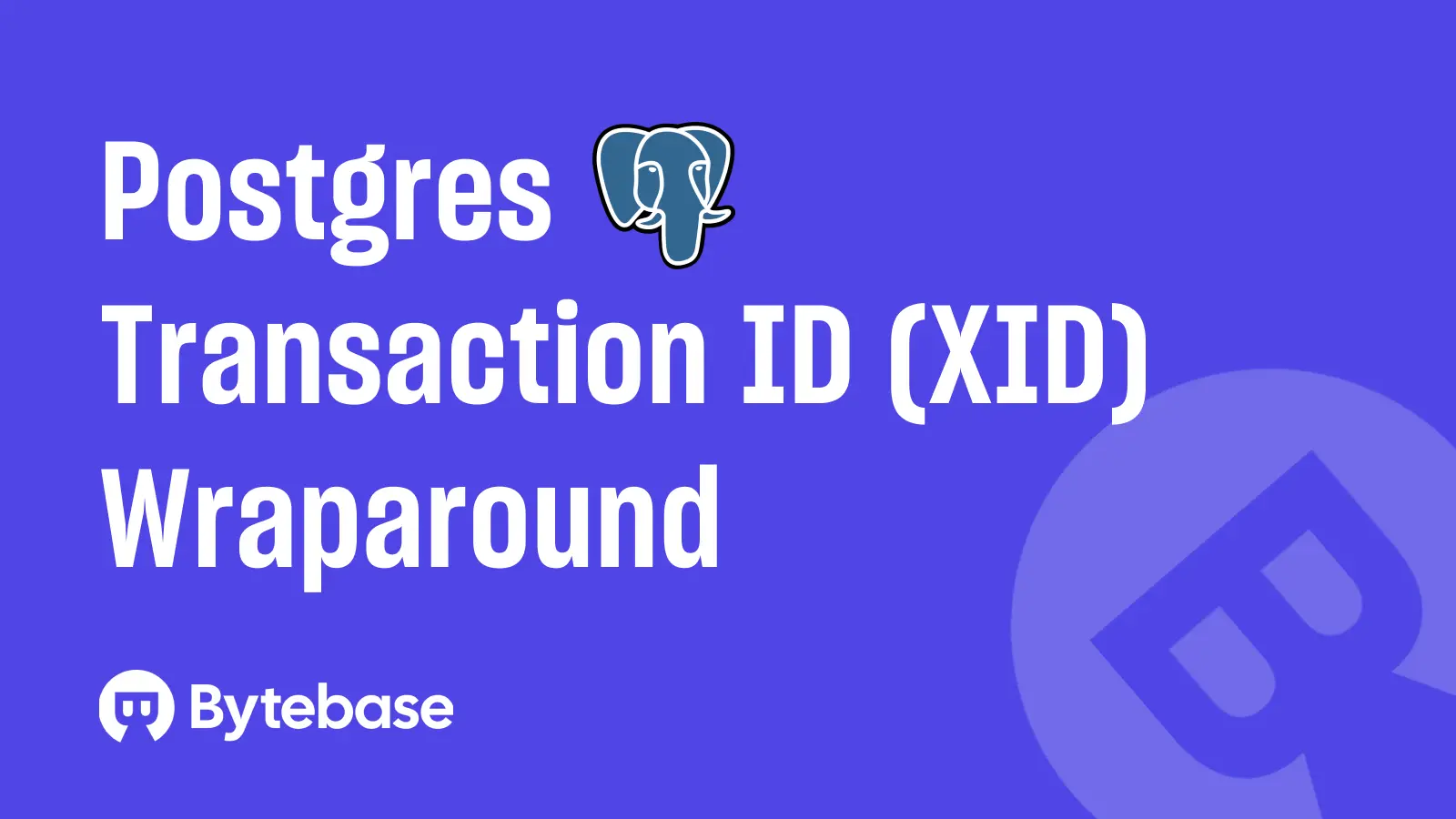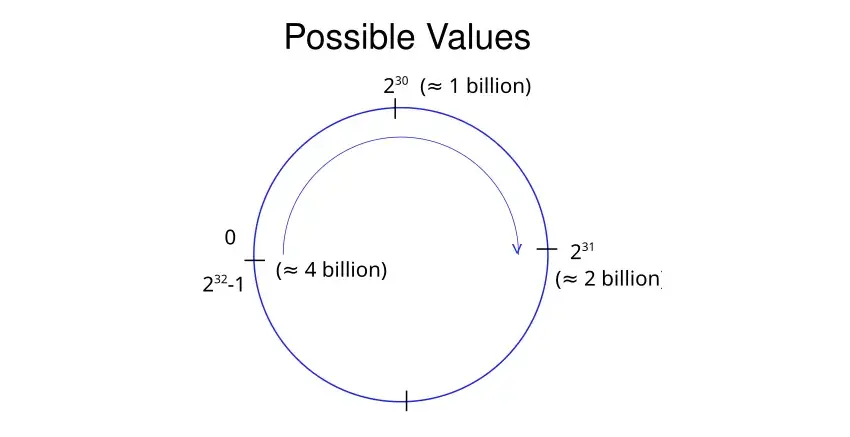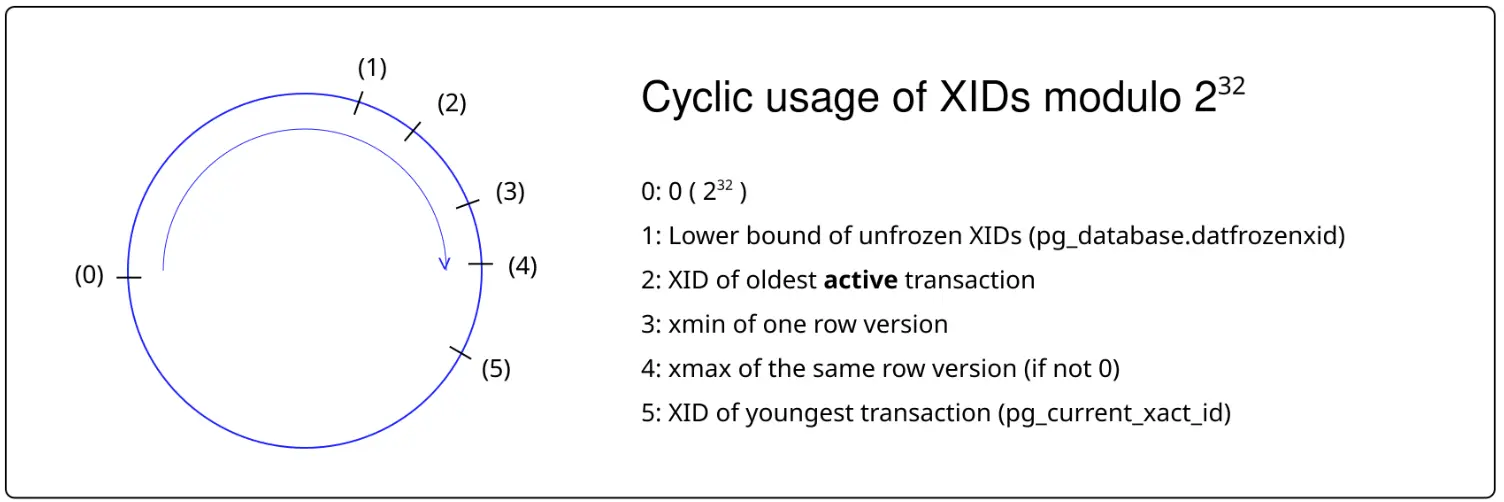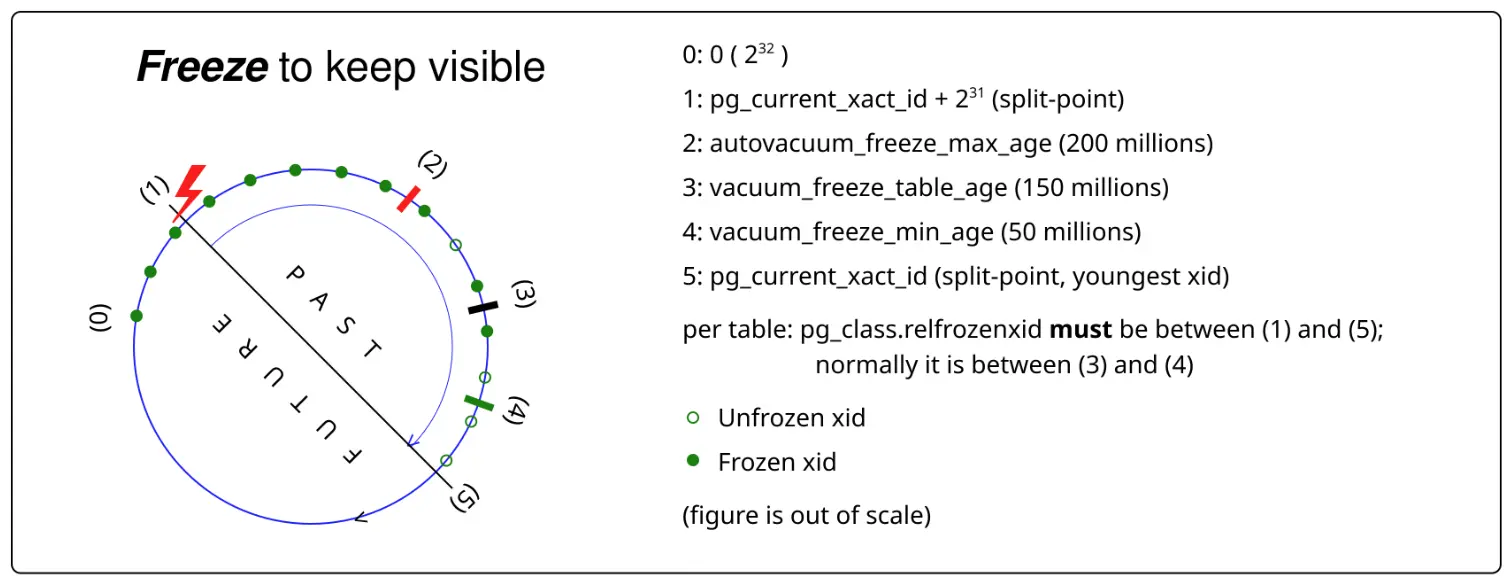
PostgreSQL’s transaction system is built around a simple but powerful idea: every transaction gets a Transaction ID (XID) - a 32-bit integer that powers its MVCC (Multi-Version Concurrency Control) engine.
MVCC lets multiple users read and write data at the same time without blocking each other. But those transaction IDs are finite, and eventually they wrap around.
If not handled properly, wraparound can make data invisible or even force the entire database into emergency shutdown. Let’s understand why.
How Postgres Differs from Other Databases
PostgreSQL uses a tuple-based MVCC model - every data change creates a new version (tuple) of a row stored directly in the table.
Each tuple has two hidden fields: xmin and xmax. xmin is the transaction ID that created the tuple, and xmax is the transaction ID that deleted or replaced it.
Other databases handle versioning differently:
| Database | MVCC type | Where old versions are stored | Wraparound risk |
|---|---|---|---|
| PostgreSQL | Tuple-based | In the main table (needs VACUUM) | ✅ Yes |
| MySQL (InnoDB) | Undo-log-based | Undo logs in system tablespace | ❌ No |
| SQL Server | Version-store-based | Tempdb version store | ❌ No |
| Oracle | Undo-log-based | Undo segments | ❌ No |
In short: PostgreSQL keeps old rows inline with the table, and each one carries its own transaction ID. That design enables powerful visibility control but also means transaction IDs must eventually be reused - leading to the wraparound problem. Other databases store old versions separately, so their transaction identifiers can grow freely without ever wrapping around.
What Is Transaction Wraparound
PostgreSQL’s transaction IDs are 32-bit integers (0 to 4,294,967,295).
After the counter hits its limit, it wraps around back to 3 again.
You can picture XIDs as points on a circle, not a straight line.

When the counter wraps, very old tuples may suddenly appear to have "future" XIDs and become invisible to all new transactions.

To prevent this, Postgres periodically freezes old tuples - marking them with a special FrozenXID, meaning "committed long ago, always visible."

Consequences of Wraparound
If the database fails to freeze tuples in time, it risks data corruption.
When datfrozenxid becomes dangerously old, Postgres refuses new writes and may shut down with errors like:
PANIC: database is not accepting commands to avoid wraparound data loss
Real-world cases
-
Sentry (2024): Sentry’s Postgres database stopped accepting writes after autovacuum couldn’t keep up with freezing old transaction IDs. The system hit the wraparound limit, forcing emergency manual vacuuming and downtime. https://blog.sentry.io/transaction-id-wraparound-in-postgres/
-
Mailchimp/Mandrill (2016): A busy shard’s autovacuum fell behind, triggering wraparound protection and halting writes. Recovery required truncations and manual vacuums, leading to roughly 40 hours of outage. https://mailchimp.com/what-we-learned-from-the-recent-mandrill-outage/
These cases show that wraparound isn’t theoretical - it’s one of the few PostgreSQL maintenance failures that can completely stop production systems.
How to Monitor and Prevent Wraparound
1. Autovacuum is the First Line of Defense
Autovacuum automatically scans tables and freezes tuples before they age out. Key parameters:
autovacuum_freeze_max_age– threshold for wraparound preventionvacuum_freeze_table_age– when to start freezing during normal vacuumvacuum_freeze_min_age– minimum XID age before freezing allowed
If autovacuum is off or slow, wraparound danger grows silently.
2. Check XID Age with SQL
To see how close your database is to wraparound:
SELECT datname, age(datfrozenxid) AS xid_age
FROM pg_database
ORDER BY xid_age DESC;For table-level detail:
SELECT relname, age(relfrozenxid) AS xid_age
FROM pg_class
WHERE relkind = 'r'
ORDER BY xid_age DESC;⚠️ Guidelines
- Above 1.5 billion → warning zone
- Above 2 billion → database may lock writes
3. Cloud Provider Recommendations
AWS RDS / Aurora
Use postgres_get_av_diag to monitor autovacuum health and aging tables —
https://aws.amazon.com/blogs/database/prevent-transaction-id-wraparound-by-using-postgres_get_av_diag-for-monitoring-autovacuum/
Google Cloud SQL Cloud SQL provides a Recommender for High Transaction ID Utilization - https://cloud.google.com/sql/docs/postgres/recommender-high-transactionid-utilization
General advice:
- Never disable autovacuum.
- Schedule manual
VACUUM FREEZEduring off-peak hours. - Avoid long-running idle transactions that block freezing.
The Challenge of Moving to 64-bit Transaction IDs
At first glance, the easiest fix would be to make transaction IDs 64-bit instead of 32-bit. That would raise the ceiling from 4 billion transactions to roughly 18 quintillion - effectively eliminating wraparound forever.
This idea has been discussed for years, with real prototypes already attempted:
-
Early discussions (2018–2019): https://www.postgresql.org/message-id/flat/DA1E65A4-7C5A-461D-B211-2AD5F9A6F2FD%40gmail.com Developers debated whether to store full 64-bit IDs or use a hybrid scheme (16-bit epoch + 48-bit XID) to retain compatibility.
-
Experimental patch for Postgres 15 (2021): https://www.postgresql.org/message-id/flat/CACG=ezZe1NQSCnfHOr78AtAZxJZeCvxrts0ygrxYwe=pyyjVWA@mail.gmail.com It proved feasible but caused major ripple effects:
- Every tuple grows by 8 bytes (
xmin+xmax). - Index and WAL formats must be redesigned.
- Replication and visibility logic rely on 32-bit arithmetic.
- Every tuple grows by 8 bytes (
-
Community view: https://news.ycombinator.com/item?id=19083745 Developers agreed the change would solve wraparound permanently but break on-disk compatibility, forcing every database to migrate storage format.
For now, the community focuses on improving autovacuum efficiency and wraparound monitoring, accepting that 32-bit XIDs remain part of the architecture - at least until a cleaner migration path emerges.
Best Practices
- ✅ Keep autovacuum enabled and tuned
- ✅ Monitor XID age regularly
- ✅ Vacuum frequently on high-write tables
- ✅ Avoid long-running transactions
- ✅ Run
VACUUM FREEZEduring maintenance windows - ✅ Partition or archive old data to reduce bloat


